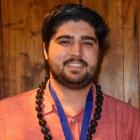Price Prize Alumni
2025
Vedant Chandra (Harvard)

Chandra’s research bridges observations, simulations, and instrumentation to reconstruct the evolutionary history of the Milky Way. He has conducted spectroscopic surveys to illuminate the outermost regions of the galactic halo, mapping its global dynamics and uncovering stellar imprints of both ancient and ongoing mergers. He is a leading member of the Via Project, developing new multi-object spectrographs to investigate the fundamental nature of dark matter and the physics of galaxy formation.
Event Page: "Tales from the Milky Way’s Distant Horizon"
Gokul Srinivasaragavan (U. Maryland)

Srinivasaragavan’s research focuses on understanding the most energetic and luminous endpoints of massive stars' lives. He does this by utilizing space and ground-based telescopes across the electromagnetic spectrum to observe, analyze, and characterize the spectacular explosions associated with the deaths of these stars. Gokul has extensive experience in studying core-collapse supernovae, long gamma-ray bursts, and the continuum of astrophysical transients that bridge the gap between these two explosive phenomena. Through his work, he has made significant progress towards illuminating long-standing open questions in this continuum, including understanding the relationship between supernova emission and central engine activity in long gamma-ray bursts, determining why only some massive stars can produce long gamma-ray bursts, and uncovering the progenitors for understudied classes of transients such as orphan afterglows and fast X-ray transients.
Event Page: "The Diversity of Massive Stellar Deaths and Relativistic Jets: Unraveling a Cosmic Tandem"
2024
Hanjue Zhu (Chicago) [Current Position: PhD candidate, University of Chicago]

Hanjue studies gas in the universe, focusing on both partially ionized gas during the Epoch of Reionization (EoR) and highly ionized gas (plasma). Using numerical simulations, her research explores the impact of cosmic reionization on the intergalactic medium and galaxies. She also investigates how observations at reionization redshifts can be used to constrain theories of galaxy formation and cosmology. In pursuit of intellectual stimulation, she tackles a variety of questions about the universe and particularly enjoys research that involves theoretical modeling and numerical simulations.
Event page: "Probing the Frontiers of Reionization: Understanding the Physics of the Intergalactic Medium
Abigail Lee (Chicago) [Current Position: PhD candidate and NASA FINESST Fellow, University of Chicago]

Abigail’s research focuses on improving extragalactic distance indicators to provide increasingly precise local measurements of the Hubble constant. She has pioneered the development of a new standard candle, the J-region asymptotic giant branch (JAGB) method, which measures distances via the constant luminosities of carbon-rich asymptotic giant branch stars. In addition to her work on the extragalactic distance scale, Abigail is also developing novel methodologies to extract galaxy age information from evolved stellar populations.
Event page: "The J-region Asymptotic Giant Branch (JAGB) method: An Independent Measurement of the Hubble Constant using Carbon Stars as Standard Candles"
2023
Dhayaa Anbajagane (UChicago) [Current Position: PhD candidate and NSF Graduate Fellow, University of Chicago]

Dhayaa's research program focuses on extracting weak lensing data from photometric surveys (like DES, DELVE etc.) and then on using these data to probe the physics of the early Universe, such as that of inflation. He develops simulation-based tools for modeling the lensing signal and thereby constraining such physics. His work shows that with the recent advances in simulation modeling and photometric data quality, the next decade of weak lensing will have a unique role to play in our pursuit of the high-energy frontier in cosmology.
Event page: "Exploring the frontiers of the primordial universe using weak lensing surveys"
Jason Hinkle (UHawaii) [Current Position: PhD candidate and NASA FINESST Fellow, University of Hawai’i]

Jason’s research aims to understand the breadth of accretion behaviors occurring on supermassive black holes. He uses a wide array of space and ground-based telescopes across the electromagnetic spectrum to investigate nuclear transients discovered by optical transient surveys. In addition to his work on tidal disruption events and active galactic nuclei, he has helped establish the growing class of ambiguous nuclear transients, which seem to defy typical observational types.
Event page: "Messy Eaters: The Feeding Behaviors of Supermassive Black Holes"
2022
Cyndia Yu (Stanford) [Current Position: KICP Postdoctoral Fellow, University of Chicago]

Cyndia works on novel instrumentation and analysis for cosmic microwave background (CMB)surveys. She is involved with the BICEP/Keck, Simons Observatory, and CMB-S4 experiments making ever more sensitive measurements of the CMB to probe a wide range of cosmological questions.
Event page: "Cosmology with Large-Angular Scale CMB Polarimetry"
Maddie Lucey (UT Austin) [Current Position: NSF Postdoctoral Fellow, University of Pennsylvania]

Maddie's research focuses on the Milky Way and how the chemodynamical properties of its stellar populations can inform theories of galaxy formation and chemical evolution. She specializes in the inner Galaxy and metal-poor, ancient stars with the aim of constraining properties of the early Universe.
Event page: "Ancient Stars and the Inner Galaxy as tracers of the Milky Way’s Early Evolution"
2021
Kaeli Hughes (Chicago) [Current Position: Assistant Professor, Ohio State University]

Kaeli's research focuses on the radio detection of astrophysical neutrinos above 10 PeV. As a collaborator on the ARA, BEACON, RNO-G, and PUEO experiments, she has built and calibrated radio detectors deployed in some of the most remote locations in the world, including the South Pole, Summit Station in Greenland, and White Mountain in California. As part of her work on ARA, Kaeli developed a targeted low-threshold neutrino search that improved the previous ARA efficiency at low energies by nearly a factor of 10.
Event page: "Turning on the radio: the search for Astrophysical Neutrinos with the Askaryan Radio Array"
Erin Kado-Fong (Princeton) [Current Position: Kavli Postdoctoral Fellow, Stanford]

Erin’s research focuses on observations of galaxy structure and assembly, with a special interest in using wide-field surveys of dwarf galaxies to better understand the processes that govern the evolution of these low mass systems. Her work with the HSC-SSP imaging survey explores the interplay and influence of mergers, star formation, and stellar feedback on the observable structure of the dwarf galaxy population at low redshifts.
Event page: "Structure, Feedback, and Formation: Dwarf galaxies in the Wide-Field Era"
2020
Carl Fields (MSU) [Current Position: Assistant Professor, University of Arizona]

Carl's research encompasses astrophysical sources of gravitational waves, stellar nucleosynthesis, and multi-dimensional simulations of core-collapse supernova explosions and their massive-star progenitors. His work utilizes multi-physics simulation frameworks such as FLASH to produce multi-dimensional supernova progenitor models. In 2020, he showed that one-dimensional models may be greatly underestimating O-shell convection speeds, a result that has crucial implications for multi-messenger signals of supernovae.
Event page: On The Development of Multidimensional Progenitor Models For Core-collapse Supernovae"
Chiara Salemi (MIT) [Current Position: Assistant Professor, University of California, Berkeley]

Chiara’s research focuses on searches for low-mass axions, one of the best-motivated dark matter candidates. She works on the ABRACADABRA and DM Radio experiments, which use a novel toroidal lumped element design to look for the coherent interactions of the field of dark matter axions around us. As a part of a small team, she built and ran the prototype detector, ABRACADABRA-10 cm, which demonstrated the technique’s viability and set the best direct limits on axion-like particles with masses around a neV.
Event page: "The Search for Low-Mass Axion Dark Matter"
2019
Carolyn Raithel (Arizona) [Current Position: Assistant Professor, Swarthmore University]

Carolyn’s research focuses on the dense-matter equation of state and its effect on a variety of astrophysical observables, from neutron star radii to core-collapse supernovae and neutron star mergers. Her work combines both analytic derivations and numerical simulations. While working on the interpretation of GW170817, she discovered a new relationship that directly maps the tidal deformability of a merger to the neutron star radius.
Event page: "Constraints on the Neutron Star Equation of State from Gravitational Wave Events"
Shany Danieli (Yale) [Current Position: Assistant Professor, Tel Aviv University]

Shany Danieli uses innovative methods and instrumentation to discover faint galaxies and study their dark matter content. She designed and leads the Dragonfly Wide Field Survey, a comprehensive survey of the low surface brightness Universe using the Dragonfly Telephoto Array. In 2019 she provided the strongest evidence yet for the existence of a class of galaxies that lack dark matter.
Event page: "Diffuse Galaxies As a Probe for Dark Matter"
2018
Kareem El-Badry (UC Berkeley) [Current Position: Assistant Professor, California Institute of Technology]

Kareem's research focuses on how galaxies form and evolve, probing underlying processes of assembly and feedback through careful measurements of their stars and gas.
Event page: "Dwarf galaxies as laboratories for astrophysics and cosmology"
Jose Manuel Zorrilla Matilla (Columbia) [Current Position: Supervisor and Instructor, Philips Academy Observatory]

José's research is on weak lensing, which is how the images of distant galaxies are distorted by the gravitational fields of intervening galaxies, and how this helps to reveal the structure and evolution of the universe.
Event page: "Extracting Cosmological Information from Weak Lensing Surveys"
2017
Charlotte Mason (UCLA) [Current Position: Associate Professor, University of Copenhagen]

Charlotte's research focuses on the evolution of galaxies at very high redshifts, including those formed just a few hundred million years after the Big Bang, and the relationship between cosmic reionization and and galaxy evolution in the early universe.
Event page: "What can galaxies tell us about the Epoch of Reionization?"
Nicholas Rodd (MIT) [Current Position: Divisional Fellow, Lawrence Berkeley Lab]

Nick's research focuses on the structure and experimental signatures associated with beyond the standard model phenomena. His current focus is dark matter and a potential signal seen in the galactic center.
Event page: "Gamma-ray Constraints on Decaying Dark Matter and Implications for IceCube"
2016
Susan Clark (Columbia) [Current Position: Assistant Professor, Stanford University]

Clark's research focuses on magnetic fields and their interaction with the interstellar medium, including the development and use of a new polarized foreground mapping technique using neutral hydrogen data. Polarized foreground maps make it possible to search cosmic microwave background data for signatures of cosmic inflation.
Event page: "Using Neutral Hydrogen to Measure Cosmic Magnetism and CMB Foregrounds"
Yuan-Sen Ting (Harvard) [Current Position: Associate Professor, Ohio State University]

Ting's research focuses on understanding the Milky Way galaxy through the technique of "chemical tagging,” which aims to unravel the fossil record of Galactic evolution encoded in the present-day chemical and kinematic properties of stars. As part of this effort, Ting is developing new tools for measuring the properties of stars from large spectroscopic surveys.
Event page: "Unraveling the History of the Milky Way"
2015
Eric Carlson (University of California, Santa Cruz) [Current Position: Senior Staff Machine Learning Engineer, Included Health]

Carlson works on the phenomenology and indirect detection of particle dark matter candidates, as well as improved modelling and characterization of astrophysical backgrounds in cosmic ray and gamma-ray studies.
Event page: "Cosmic Ray Protons in the Inner Galaxy and the Galactic Center Gamma-Ray Excess"
Adrian Price-Whelan (Columbia) [Current Position: Assistant Director, Simons Foundation]

Price-Whelan's research interests are on tidal streams and Galactic dynamics.
Event page: "Tidal streams in triaxial systems"
2014
Shea Garrison-Kimmel (University of California, Irvine) [Current Position: Senior Software Engineer, Medallion]

Garrison-Kimmel is working on studies of dwarf galaxies near the Milky Way and Andromeda as probes the physics of the larger Universe, including the nature of dark matter, the small-scale physics of star formation, and the interplay between dark matter and baryons.
Alessandro Sonnenfield (University of California, Santa Barbara) [Current Position: Associate Professor, Shanghai Jiao Tong University]

Sonnenfeld is working on studies of massive elliptical galaxies, from how much dark matter they contain and how it is distributed to how the interplay of dark matter and ordinary matter leads to the observed properties of these galaxies, probed with direct observations and through the gravitational lensing of background galaxies.
2013
Liang Dai (Johns Hopkins University) [Current Position: Assistant Professor, University of California, Berkeley]

Liang is a theorist; he is working on identifying signatures of the seeds of structure formed just after the Big Bang, when the universe was extremely young, dense, and hot.
Jessica Stockham (University of Kansas) [Current Position: Senior Algorithm Engineer, Full Swing Simulators]

Stockham is an experimentalist; she is working on new techniques to detect ultra-high-energy neutrinos and cosmic rays and to determine the nature of their source.
2012
Charlotte Strege (Imperial College, London) [Current Position: ETF Market-Making Quantitative Researcher, Citadel Securities]

Strege is a theorist; she is probing the unknown particle properties of dark matter through combining results from astrophysical, underground, and collider experiments.
Chris Williams (University of Chicago) [Current Position: Specialist Leader, Deloitte]

Williams is an experimentalist; he is working on new techniques to detect the highest-energy particles in the universe, seeking clues to their unknown origins.
2011
Sayan Chakrabortif (Tata Institute) [Current Position: Principal, Renaissance Technologies]

Chakraborti works on the mechanisms and consequences of supernovae and gamma-ray bursts.
Michele Fumagalli (Santa Cruz) [Current Position: Professor, University of Milano Bicocca]

Fumagalli works on how galaxies and their stars form across cosmic time. An unusual aspect of their work is that each has worked on both theory and observation.
2010
Jo Bovy (New York University) [Current Position: Professor and Canada Research Chair, University of Toronto]

As a current physics PH.D. student at NYU, Mr. Bovy is doing research at the Center for Cosmology and Particle Physics (CCPP). He received his Masters in Physics and Mathematics from Katholieke University Leuven, Belgium in 2005. His research focuses on the Milky Way as well as topics related to the transparency of the Universe and non-gravitational interactions in the dark sector.
2009
Charlie Conroy (Princeton University) [Current Position: Professor of Astronomy, Harvard University]

Mr. Conroy received his B.A. in Physics and Astrophysics from UC-Berkeley (2005) and is currently finishing his graduate degree at Princeton. His award recognizes his remarkable research accomplishments in the areas of galaxy formation, large scale structure, and, more recently, the use of the colors and spectra of galaxies as a tool to infer the properties of their stellar populations.
